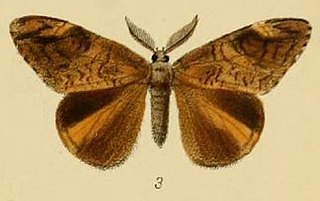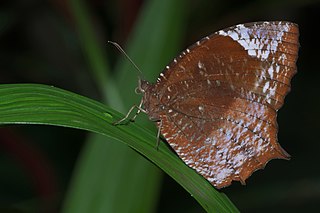
The Bhagavata tradition, also called Bhagavatism, refers to an ancient religious sect that traced its origin to the region of Mathura. After its syncretism with the Brahmanical tradition of Vishnu, Bhagavatism became a pan-Indian tradition by the second century BCE, according to R.C. Majumdar.

Alseodaphne is a genus of plants in the family Lauraceae, endemic to China and Southeast Asia. The genus has 96 species of evergreen trees to shrubs. They have bisexual flowers, a fruit stalk that is red, green, or yellow, and black fruit.

Cigaritis is a genus of butterflies in the family Lycaenidae. Its species are found in the Afrotropical realm, the Indomalayan realm and adjacent regions of Asia.

Aroa is a genus of moths in the subfamily Lymantriinae first described by Francis Walker in 1855. Species are distributed in South Africa, China, throughout India, Sri Lanka, Myanmar, and Java.

Halpe is a genus of grass skippers in the family Hesperiidae. It is found in the Indomalayan realm.

Om Namo Bhagavate Vāsudevāya is one of the most popular mantras in Hinduism, and according to the Bhagavata tradition, the most important mantra in Vaishnavism. It is called the Dvadasakshari Mantra, or simply Dvadasakshari, meaning the "twelve-syllable" mantra, dedicated to Vishnu or Krishna.

The palmflies are a common Asian butterfly genus found from India to the Solomon Islands. The caterpillars mimic leaves which they feed on. The adults mimic certain species.

Elymnias nesaea, the tiger palmfly, is a butterfly in the family Nymphalidae.

Genianthus is a genus of plants in the family Apocynaceae, first described as a genus in 1883. It is native to southern China, the Indian Subcontinent, and Southeast Asia.
Oreta griseotincta is a moth in the family Drepanidae. It was described by George Hampson in 1893. It is found in China, Taiwan, north-eastern India, Sikkim, Malaysia and Singapore.
Ditrigona quinaria is a moth in the family Drepanidae. It was described by Frederic Moore in 1867. It is found in China, Tibet and India.
Parapsestis lichenea is a moth in the family Drepanidae. It was described by George Hampson in 1893. It is found in Sikkim in India, Myanmar, Thailand, Vietnam and the Chinese provinces of Henan, Shaanxi, Zhejiang, Hubei, Fujian, Sichuan, Yunnan and Tibet.

Elymnias caudata, the tailed palmfly, is a species of satyrine butterfly found in South India. Some authors consider this as a subspecies of Elymnias hypermnestra.

The Vishnu nicolo seal is a "finely engraved" oval agate seal from the Gandhara region, dated to the 4th century CE. Since 1892 it has been in the British Museum. Nicolo is an abbreviation of the Italian onicolo, meaning "little onyx", a type of stone, often made of different layers in various shades of blue, used for intagli.

Elymnias malelas, the spotted palmfly, is a butterfly in the family Nymphalidae. It was described by William Chapman Hewitson in 1863. It is found in northern India and Indochina in the Indomalayan realm.

Elymnias patna, the blue-striped palmfly, is a butterfly in the family Nymphalidae. It was described by John Obadiah Westwood in 1851. It is found in the Indomalayan realm.













